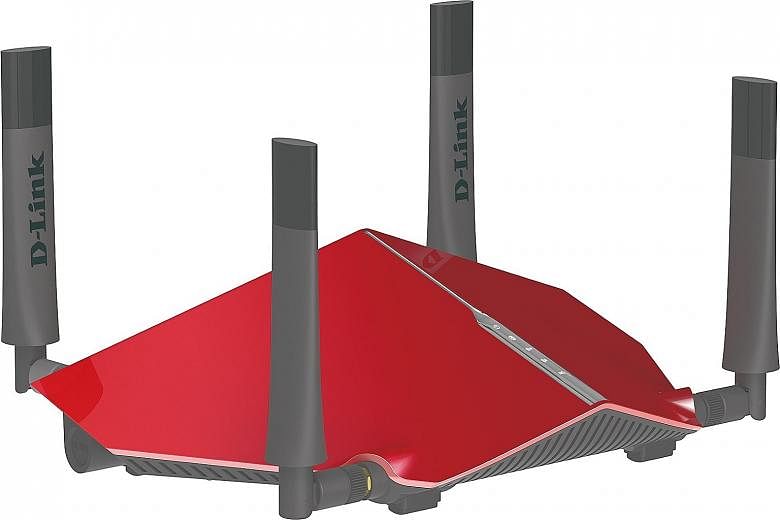D-Link's latest router bears a close resemblance to its previous 890L model. Both have an unforgettable futuristic design that could easily double as props in a sci-fi movie.
While the older model has three wireless bands, the new DIR-885L has just two. Both routers have a similar Smart Connect feature that automatically places your client devices in the appropriate wireless band so as to optimise their performance.
In other words, a user connecting to the router will simply see a single network instead of separate 2.4GHz and 5GHz bands. This reduces confusion, especially for those who are less tech-savvy.
More importantly, you do not need to worry that devices using an older and slower wireless standard will affect the wireless speeds of those using the latest 802.11ac standard.
The new model has four adjustable external antennae. Each antenna supports a spatial stream, with each stream capped at a maximum data transfer rate of 433Mbps. Add them together for an aggregate bandwidth of 1,733Mbps on the 5GHz band.
-
TECH SPECS
PRICE: $379
ETHERNET INTERFACE: 1 x 10/100/1,000 Gigabit WAN, 4 x 10/100/1,000 Gigabit LAN
STANDARDS: 802.11a/b/g/n/ac
SECURITY: WPA/WPA2, WEP
ADVANCED FIREWALL FEATURES: NAT and SPI, DoS protection
-
RATING
FEATURES: 4/5
DESIGN: 4/5
PERFORMANCE: 3/5
VALUE FOR MONEY: 2/5
OVERALL: 3/5
But this router uses a Broadcom chipset, which has proprietary technology that boosts the aggregate speed to 2,167Mbps. This, with the transfer rate on the router's 2.4GHz band, results in the D-Link's advertised 3,150Mbps speed.
However, these speeds are possible only if the clients use a compatible Broadcom chip. This is often not the case. Furthermore, most clients, such as laptops, support just two spatial streams. Exceptions are desktop adaptors, such as the USB wireless adaptor used to test this D-Link router. It supports three spatial streams, or 1,300Mbps.
Another of its features that seems underwhelming at this moment is MU-MIMO (multi-user-multiple-input and multiple-output), which lets the router send data to multiple clients simultaneously. Again, it is something that works only if your client supports it, but few compatible devices are available now.
During my test, the D-Link recorded an average speed of 495Mbps. This is decent enough, but not close to the 695Mbps top download speed that I have experienced on the Asus RT-AC5300 router.
The 885L's current interface was introduced by D-Link last year. It looks modern and clean. For instance, a graphical map of the network shows the connected devices - one simply needs to click on a client to configure specific settings, such as turning on parental controls. Another example of the router's ease of use - you can drag and drop clients into different priority tiers in the router's quality-of-service engine instead of re-ordering them on a list.
However, I did find the router interface to be slower than expected when saving changes. It would take around 30 seconds, compared with other routers that take less than 10 seconds.
•Verdict: Its major features have potential, but do not make a difference for now. Interface is neat and user-friendly .


